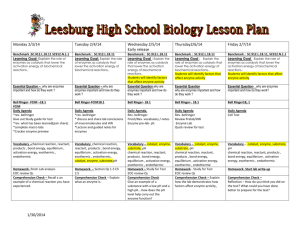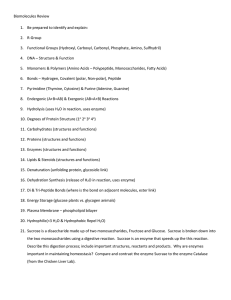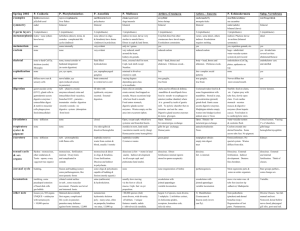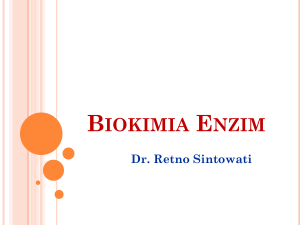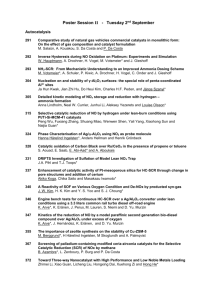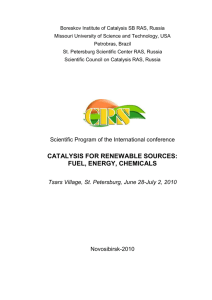serine proteinases
advertisement
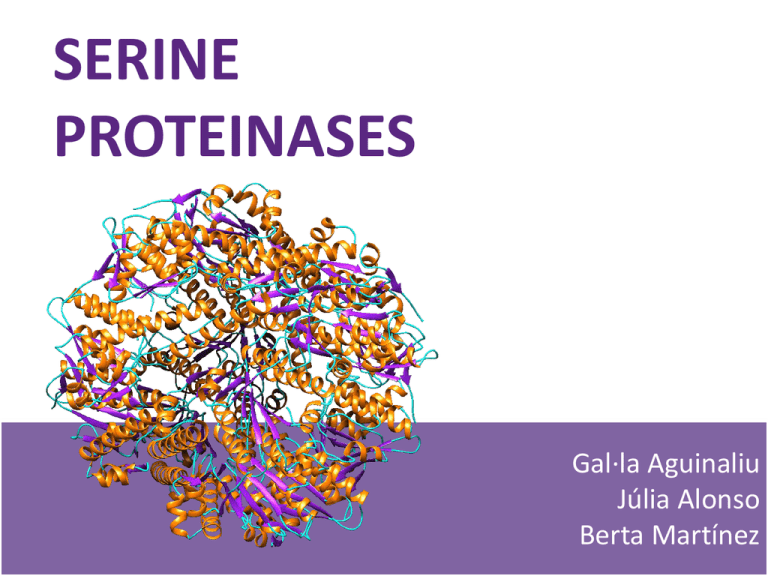
SERINE PROTEINASES Gal·la Aguinaliu Júlia Alonso Berta Martínez INDEX • • • • • • Introduction General mechanism of action Different topologies and foldings Results Conclusions References INTRODUCTION Proteinases • Proteinases catalyse the hydrolysis of covalent peptide bonds • Found in: Animals, plants, bacteria, archea and viruses • Groups: Serine Cysteine Threonine Aspartic Metallo Introduction to serine proteinases • Presence of a nucleophilic serine residue at the active site of the enzyme • Crucial roles in a wide variety of cellular and extracellular functions: blood clotting, protein digestion, cell signaling, inflammation and protein processing. 1/3 Of all known proteinases identified Abundance measure of succes in evolutionary terms These enzymes deserve attention MEROPS classification MEROPS database • Clans: based on catalytic mechanism • Families: based on common ancestry Degradome Degradome: peptidases present within a genome PA Eukariotic 4 families account for over 40% of the human degradoma SB, SC Archea, prokaryotes, plants and fungi • • • • Ubiquitin- specific peptidases (CA, C19) Zn- dependent adamalysins (MA, M12) Prolyl oligopeptidases (SC, S9) Trypsin-like serine peptidases (PA, S1, A) SCOP classification SCOP Prokaryotic proteinases Eukaryotic proteinases Trypsin like Viral proteinases Viral cysteine proteinase of trypsin fold Subtilases Subtisilin like Serine-carboxyl proteinase Trypsin Chymotrypsin Elastase Trypsin-like: Zimogen activation Zimogen: inactive enzyme precursor Enteropeptidase Trypsinogen Proelastase Elastase Trypsin Chymotrypsinogen Chymotrypsin Trypsin-like: Zimogen activation Chymotrypsinogen activation Chymotrypsin Chymotrypsinogen Asp 194 Ile 16 Chymotrypsinogen activation Chymotrypsin Chymotrypsinogen Binding site MECHANISM OF ACTION Chemical mechanism of serine proteinases Four important structural features required for the catalitic action of SP: 1. 2. 3. 4. Catalytic triad The oxanyon hole Polypeptide binding site Specificity pockets Trypsin-like SP – Catalytic triad The catalytic triad spans the active site cleft, with Ser195 on one side and Asp102 and His57 on the other. Trypsin-like SP – Catalytic triad His2 Asp2 Ser2 Trypsin-like SP – The oxanyon hole The oxanyon hole (Gly193 and Ser195) Cathalytic triad Trypsin-like SP – Substrate recognition site Substrate recognition site Trypsin-like SP – Specificity pocket Gly 216 Gly 226 Gly 226 Gly 216 Asp 189 Ser 189 Chymotrypsin Trypsin Thr 226 Val 216 Elastase Covalent bond formation Tetrahedral transition state Acyl-enzyme intermediate Water activation Tetrahedral transition state Enzyme regeneration and product formation Summary of the catalytic mechanism Superimposition B-trypsin + Inhibitor 2AH4 Ser195 His57 Asp102 Inhibitor • Cyan: Beta-trypsin • Inhibitor: 4-guanidinobenzoic • Magenta: Beta-trypsin + Inhibitor acid • 2.233 A: distance betwen Ser195 and Inhibitor Superimposition B-trypsin + Inhibitor 2AH4 Leupeptin inhibitor 2AGI Leupeptin inhibitor His 57 2AGI Asp 102 Ser 195 Asp 189 TOPOLOGY and FOLDINGS Trypsin-like 1FMG Chymotrypsinogen evolution, gene duplication • Evolution by gene duplication from a single ancestor proteinase domain Trypsin-like 1FMG Greek key 3 2 1 Beta hairpin 4 5 6 • Trypsin – Fold: Trypsin-like serine proteinases – Barrel – Greek-key – Duplication: consists of two domains of the same fold Subtilisin-like 1ST3 • Subtilisin – 3 layers: a/b/a – Parallel beta-sheet of 7 strands – Left-handed crossover connection between strands 2 & 3 Subtilisin-like 1ST3 • Subtilisin – 3 layers: a/b/a – Parallel beta-sheet of 7 strands – Left-handed crossover connection between strands 2 & 3 Subtilisin-like 1ST3 • Subtilisin – 3 layers: a/b/a – Parallel beta-sheet of 7 strands – Left-handed crossover connection between strands 2 &3 Prolyl oligopeptidase C-terminal 1QFS N-terminal Prolyl oligopeptidase 1QFS • N-terminal domain – Fold: 7-bladed beta-propeller • Seven 4-stranded beta-sheet motifs • Meander Prolyl oligopeptidase 1QFS • C-terminal domain – Fold: Alpha/beta-Hydrolases • Core: 3 layers, a/b/a • Mixed beta-sheet of 8 strands • Strand 2 is antiparallel to the rest Clp peptidase • Clp peptidase – Fold: Clp/crotonase – Core: 4 turns of beta (beta-beta-alpha)n superhelix 1YTF RESULTS Chymotrypsins’ sequence alignment, CLUSTALW His 57 Asp 102 Oxyanion hole Main chain substrate binding Ser 195 Trypsin-like enzymes’ sequence alignment, HMM His 57 Asp 102 Ser 195 Oxyanion hole Main chain substrate binding Trypsin-like enzymes’ sequence alignment based on structure, STAMP His 57 Asp 102 Ser 195 Oxyanion hole Main chain substrate binding Trypsins from different species’ superimposition • Streptomyces griseus, Trypsin • Sus scrofa, Beta Trypsin • Bos taurus, Trypsinogen Sc 8.71 RMS 1.27 Trypsin-like enzymes’ superimposition • H. sapiens, plasma kallikrein • Sus scrofa, Beta Trypsin • H. sapiens, blood coagulation factor XA Sc 8.94 RMS 1.02 Trypsin-like enzymes’ superimposition • Divergent evolution Subtilisin-like enzymes’ sequence alignment, CLUSTAL Asp 32 His 64 Oxyanion hole Main chain substrate binding Ser 221 Subtilisin-like enzymes’ sequence alignment, HMM Asp 32 His 64 Main chain substrate binding Oxyanion hole Main chain substrate binding Ser 221 Subtilisin-like enzymes’ alignment based on structure, STAMP Asp 32 His 64 Main chain substrate binding Oxyanion hole Main chain substrate binding Ser 221 Subtilisin-like enzymes’ superimposition • D. nodosus, acidic extracel. subtilisin-like proteinase • Vibrio sp., cold adapted subtilisin • B. licheniformis, subtilisin carlsberg Sc 7.82 RMS 1.29 Serine proteinases’ superimposition • H. sapiens, neutrophil elastase (trypsin-like) • B. licheniformis, subtilisin carlsberg • A. sendaiensis, kumamolisin apoenzyme (serine-carboxi peptidase) Sc 1.48 RMS 4.14 Trypsin-subtilisin superimposition • Sus scrofa, Beta trypsin • B. licheniformis, subtilisin carlsberg Sc 0.54 RMS 2.47 Similar catalytic triad, convergent evolution Trypsin Subtilisin His2 His2 Ser2 Ser2 Asp2 Asp2 Hydrogen bonds Tryspin (Distances A) Subtilisin (Distances (A) N1-H of His57 and O1 of Asp102 2.739 2.839 OH of Ser195 and N2-H of His57 3.237 3.027 O2 of Asp102 and NHs His57 2.966 4.511 CONCLUSIONS Conclusions • Divergent evolution and gene duplication in trypsin-like enzymes • Convergent evolution between trypsin-like enzymes and subtilisin-like enzymes • Different structure • Different sequence • Same mechanism of action PROGRAMMES USED Programmes used • • • • • • ClustalW HMM STAMP XAM Chimera Rasmol PDB Protein Species PDB Subtilisin Bacillus lentus 3BX1, 1ST3 Subtilisin Bacillus amyloliquefaciens 1SBT Sus scrofa 1QFS Clp peptidase Escherichia coli 1TYF Plasma kallikrein Homo sapiens 2ANW Factor XA Homo sapiens 1HCG Bos taurus 1TGN Streptomyces griseus 1SGT Subtilisin Bacillus clausii 1MPT Subtilisin Savinase Bacillus lentus 1NDQ Selenosubtilisin Bacillus subtilis 1SEL Thermoactinomyces vulgaris 1THM Mesentericopeptidase (subtilisinlike serine proteinase) Bacillus pumilus 1MEE Chymotrypsin inhibitor CI-2 Hordeum vulgare 2SNI Prolyl oligopeptidase Beta-trypsinogen Trypsin Thermitase (subtilisin-like serineproteinase) PDB Protein Species PDB Dichelobacter nodosus 3LPC Vibrio sp 1S2N Bacillus licheniformis 1YU6 Extracellular subtilisin-like proteinase Vibrio sp. 1SH7 serine-carboxyl proteinase Pseudomonas sp. 1GA6 Alicyclobacillus sendaiensis 1SN7 Bacillus sp. 1T1G Neutrophil elastase Homo sapiens 3Q76 Chymotrypsinogen A Bos taurus 1EX3 Gamma-Chymotrypsin A Bos taurus 1GMC Cationic trypsin Bos taurus 4I8G Beta- Trypsin Sus scrofa 1FMG Elastase Sus scrofa 1C1M Chymotrypsin Bos taurus 1GMC, 2CHA Subtilisin-like proteinase APRV2 Cold adapted subtilisin-like serine proteinase Subtilisin Carlsberg Kumamolisin-As (serinecarboxil proteinase) Kumamolisin REFERENCES References • Di Cera, E. (2009). Serine proteases. IUBMB Life, 61(May), 510–515. doi:10.1002/iub.186 • Hedstrom, L. (2002). Serine protease mechanism and specificity. Chemical Reviews, 102, 4501–4523. doi:10.1021/cr000033x • Page, M. J., & Di Cera, E. (2008). Serine peptidases: Classification, structure and function. Cellular and Molecular Life Sciences, 65, 1220– 1236. doi:10.1007/s00018-008-7565-9 • Polgár, L. (2005). The catalytic triad of serine peptidases. Cellular and Molecular Life Sciences, 62, 2161–2172. doi:10.1007/s00018-005-5160-x • Branden & Tooze (1998), Introduction to protein structure, 2nd ed. • W. Pratt & Cornely (2013), Essential Biochemistry, 3rd ed. PEM 1. Which of these residues are part of the catalytic thriad in serine proteinases? a) Asp-Ser-His b) Asp-Thr-His c) Ser-Asp-Thr d) Ser-Gly-His e) Asp-His-Thr 2. Proteinases are found in: a) Animals b) Bacteria and plants c) Archaea and viruses d) All of the answers above are incorrect e) a, b and c are correct 3. Regarding trypsin-like and subtilisin-like enzymes, they both have similar: a) Structure b) Sequence c) Catalytic thriad d) Function e) A, b, c and d are true 4. A superimposition with STAMP of different chymotrypsins from different species… a) could probably have a SC value lower than 5.5 b) could probably have a SC value lower than 2 c) could probably have a SC value between 5.5-9.8 d) will probably have a RMSD value higher than 2 e) will probably have a RMSD value higher than 5.5 5. Which different proteinases groups do exist? a) Serine and cystein b) Serine, cystein, threonin and glycine c) Cystein, serine, threonin, aspartic and metallo d) Cystein, metallo, serine, glycine and histidine e) All of the answers are incorrect PEM 6. Which are the four important features in serine proteinases? a) the oxyanion hole, the non-specificity pocket, the catalytic triad, and the substrate binding cleft b) Catalytic triad, the oxyanion hole, the non-specificity pocket and the substrate binding site c) Catalytic triad, the oxyanion hole, the specificity pocket and the substrate binding site d) Ser-Gly-His-Asp e) Asp-His-Thr-Ser 7. Evolution processes in trypsin like enzymes and in subtilisin-like enzymes: a) Divergent evolution and gene duplication in substilisin-like enzymes b) Convergent evolution in different trypsin-like enzymes c) Gene duplication in subtilisin-like enzymes d) Divergent evolution in trypsin-like enzymes and convergent evolution between trypsin-like enzymes and subtilisin-like enzymes e) a, b and c are correct 8. Regarding serine proteinases tridimensional structure and folding: a) Trypsin-like enzymes have a left-handed crossover connection b) Trypsin-like enzymes contain an anti-parallel betta sheet composed of 10 strands c) Subtilisin-like enzymes contain a parallel betta sheet composed of 10 strands d) Trypsin-like enzymes and subtilisin-like enzymes have similar structure e) Every answer above is incorrect 9. Which serine proteinase clan is most representative of the eukariotic proteome? a) PA b) SK c) SB d) SH e) SJ 10. About zimogen activation in trypsin-like serine proteinases, which answer is correct: a) Activation of trypsinogen to trypsin recquires a cleavage of 15-16 residues b) Activation of trypsin to trypsinogen recquires a cleavage of 15-16 residues c) Endopeptidases activate chymotrypsunogen into chymotrypsin d) Elastase is synthetised as an already active enzyme in the duodenum e) All answers are incorrect
